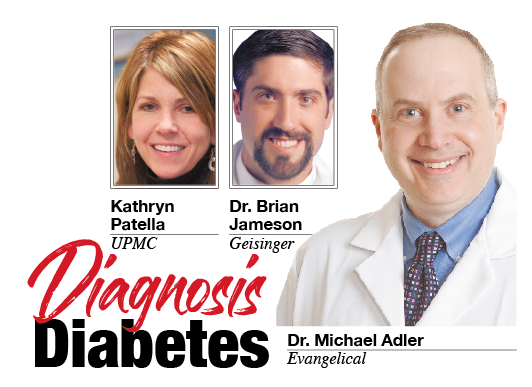Diagnosis Diabetes Part 1: Lifestyle changes key to avoiding Type-2 condition
Editor’s note: This is the first in a two-part series on Type-2 diabetes. Check out the first part by clicking here.
According to the American Diabetes Association, the total cost of diagnosed diabetes in the United States in 2017 cleared $327 billion.
The cost to those who develop the potentially deadly condition, however, can be much higher if not taken seriously.
“Type 2 diabetes is a small and large vessel disease, and if left uncontrolled, can cause numerous systems in the body to not function properly and even fail completely,” said Dr. Michael Adler, endocrinologist with Evangelical Community Hospital. “It can lead to numerous cardiovascular issues within the heart, severely impact the kidneys and cause both eye issues and nerve problems that can lead to other issues.”
An estimated 29.1 million people in the United States have diabetes, but 8.1 million may be undiagnosed and unaware of their condition according to the American Diabetes Association. About 1.4 million new cases of diabetes are diagnosed in the United States every year. More than one in every 10 adults who are 20 years or older has diabetes.
All about the insulin
Type 2 diabetes is a condition where the body produces too much insulin and can’t process it as well.
“Ultimately, you get to a point where your pancreas makes more and more insulin that works less and less well,” said Dr. Brian Jameson, endocrinologist with Geisinger Medical Center. “It can start as something that is mildly abnormal, then lead to pre-diabetes and eventually to an official diagnosis of Type 2 diabetes.”
The difference between pre-diabetes and Type 2 diabetes comes down to the numbers, according to Kate Patetta, program coordinator of UPMC Susquehanna’s diabetes and nutrition center.
“Blood tests that look for glucose levels can be a good indicator — those that show a glucose level between 100-125 is considered pre-diabetic while anything over 126 can be full-fledged diabetes,” she said. “Another test is called the A1C which looks at average levels of blood glucose over three months. For that, a level of 5.7 to 6.4 is considered pre-diabetic while 6.5 or higher is an indicator of diabetes.”
Silent symptoms
Early detection of potential diabetes offers the best chance for the patient to change lifestyle habits and hopefully avoid the condition, according to Adler, but unfortunately, symptoms aren’t always noticeable.
“Sometimes it is considered a silent disease — some people have some variation of it for 10 or 15 years without diagnosis, and unfortunately once they get to diagnosis, it is a lot harder to manage things,” he said.
Diabetes red flags include excessive thirst, excessive urination — including waking up in the middle of the night to urinate, changes in vision and an unexplained weight loss.
Additional symptoms in some cases, according to Jameson, include increased fungal infections, boils, vaginal yeast infections and urinary tract infections.
“The earlier signs of diabetes developing may include some of these symptoms to a milder degree, and in these cases, it can provide a warning flag that things need to change before an official diagnosis becomes necessary,” he said.
Risk factors vary
A family history of diabetes can be a good indicator that things could be an issue, according to Patetta, as can obesity.
“People with Type 2 diabetes typically carry more weight in the trunk area, and all the major organs are typically in that region of the body, including the pancreas which produces insulin,” she said. “The extra fat can affect how insulin is used.”
Patetta added that age can be a factor (those 45 and older are more likely to develop the condition), as can a history of gestational diabetes or giving birth to a baby nine pounds or heavier and certain ethnic groups can be at a higher risk.
Making changes
Certain medications and other therapies may be able to reverse the course of a potential diabetes diagnosis, but according to Jameson, the most effective change to make involves diet and exercise.
“At least half — if not more — of the issue with diabetes management revolves around lifestyle habits,” he said. “If it looks like you are going down a path towards a possible diagnosis of diabetes, slowly work your way up to a point where you are doing more and more physical activity. Get your heart rate up a little bit and pay attention to the nutrition labels and serving sizes they put on foods now.”
He suggested meeting with a dietitian for a better education on what foods are best to reverse an increased glucose level.
“People don’t realize that even things like salads and fruits have carbohydrates in them,” Jameson said. “Education is one way to help you manage your life and improve metabolism. It is important to figure out if you can control your situation with the choices you make or if medications are necessary.”
If that does become needed, Adler added that different people react in different ways to medication.
“Medications like metformin can help delay the onset of diabetes. In larger studies, it was found that some selected groups saw better response to the medication than others,” he said. “Another thing that may be helpful is weight-loss surgery or other things that can help take stress off the body.”

